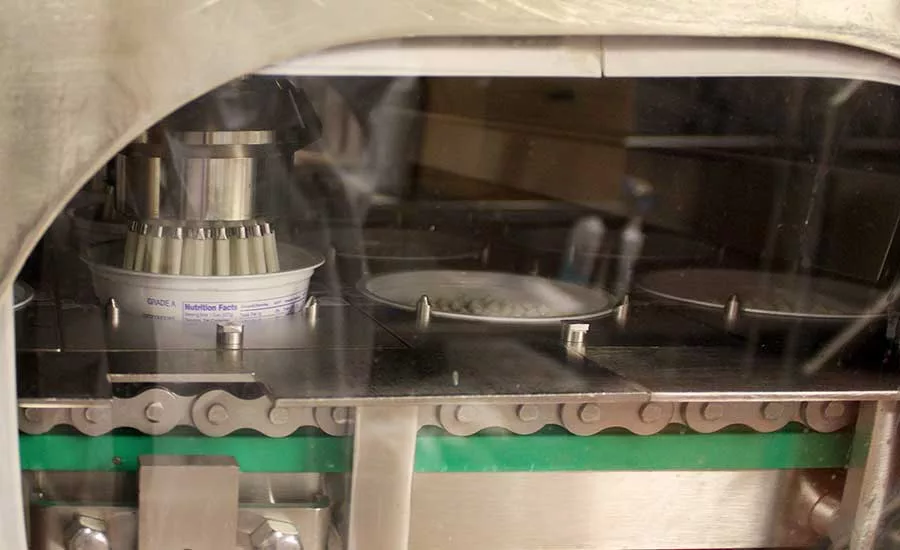Manufacturing News
What FSMA requires for environmental monitoring
Not all food and beverage plants require the same amount of environmental monitoring

(Looking through a glass porthole): Does this dairy cup filling application constitute “exposed” product? What about the short travel length to the capper? Do HARPC environmental rules apply? Photo: Wayne Labs.
Not all food and beverage plants require the same levels of environmental monitoring, but for those facilities (especially RTE) that do, several issues have risen to the surface in terms of FSMA requirements—both in sampling location(s) and frequency, and in the depth (e.g., species, strains) of pathogen testing to be used. These issues were brought to the forefront in a recent FSMA Friday webinar featuring Dr. David Acheson, president and CEO of The Acheson Group and former FDA CFSAN associate commissioner for foods. The monthly webinar is hosted by SafetyChain Software.
Under FSMA’s CGMP, HARPC for Human Food, product testing and environmental monitoring are listed as possible verification activities. But like other preventive control management components, they are required when appropriate to the type of food produced and facility, as well as the nature of the preventive control and the preventive control’s role in the facility’s food safety system.
Acheson advises processors affected by this rule to focus specifically on environmental monitoring for two reasons. First, FDA mandates an environmental monitoring program (EMP), and processors need to tailor it to their specific application. Second, there is always the regulatory risk of a recall, and a recall is not only an operational risk, it’s also a risk to the brand’s reputation.
When is an environmental program required? According to FSMA, these programs are “to verify the effectiveness of pathogen controls in processes where a food is exposed to a potential contaminant in the environment.” But how should “exposed” be defined?
“If you are making an RTE food,” Acheson explains, “and it is exposed to your manufacturing or processing environment—and by that, my interpretation is if it’s coming out of a process … and it’s not cooked in a bag, can, bottle or anything, even if only briefly—then it falls into the category of exposed.”
At that point, it’s very critical that manufacturers do a risk assessment.
If the cooked food is exposed to the plant’s environment before packaging and does not get a further kill step, then environmental monitoring is required. However, environmental monitoring might not be required, according to Acheson, if the exposed product is packaged with a formulation designed to kill bacteria or if it is cooked or pasteurized in the bag.
Tests and testing
Before putting an EMP into place, processors need to check the details of the rule concerning labs, assay types and documentation methods. Many labs and processors begin checking for the presence of any Listeria species, which Acheson approves, as long as the processor reacts to any positive test results appropriately. One single incident remediated properly is not an issue—as long as further tests come back negative.
However, if five or six positives result in a matter of months, that could be troublesome, especially if the samples are collected from different places. If there are recurring positives, the type of Listeria strain needs to be determined, as the remediation will be different, especially if it is Lm. A transient strain of a harmless Listeria species could have come in on someone’s boots and not be Lm, while static Listeria could be in a machine (e.g., as at Maple Leaf Foods), drain or crack on the wall, because it hasn’t been discovered or wiped out. Worse yet, it could be Lm.
Today’s genetic tests, like whole genome sequencing (WGS), are affordable and worth doing, because they can reveal if it’s Lm or a less harmful species of Listeria. These tests can also determine the strain of a particular Lm and whether it is the same strain showing up in samples from other plant locations or from last year. In especially the latter case, FDA could force a recall or shut down a line or plant until it is satisfied the situation has been remediated.
It’s this advanced diagnostic capability of WGS that also poses a problem.
“It’s the fear of regulatory action … [which] is actually impeding good food safety practices,” says Acheson.
Some processors are reluctant to use WGS, because it could reveal a strain of Lm that has been resident for some time without sufficient remediation, creating a serious FDA action.
“We’re starting to get into a situation where we’re not using the best technology and tools for fear of regulatory action,” says Acheson. “That’s backwards—it’s not the way it should be.”
Looking for a reprint of this article?
From high-res PDFs to custom plaques, order your copy today!






